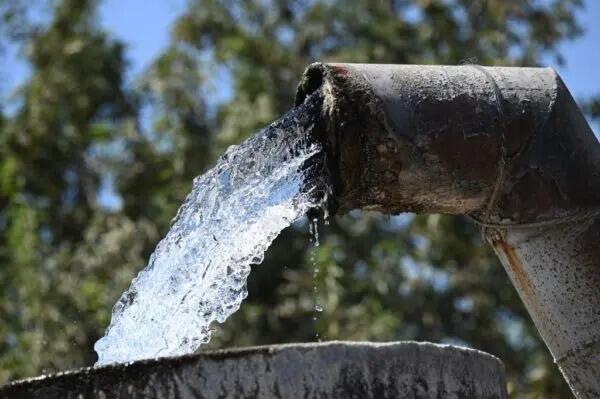Hundreds Of Failing Water Systems In California Need Funding For New Infrastructure
Authored by Summer Lane via The Epoch Times,
Nearly 400 public water systems in California have failed to meet recommended safety standards for drinking water, according to a report last month from the State Water Resources Control Board, but a new climate bond measure recently joined the state’s November ballot may help.
Some 913,000 Californians, approximately 2 percent of the state’s population, are potentially affected by 385 failing public water systems according to the report.
Fifty-six of those systems “serve disadvantaged communities and 67 percent serve majority communities of color.”
The annual report identifies California drinking water challenges, part of an effort to improve access to safe drinking water started by former Gov. Jerry Brown. He signed Assembly Bill 685 into law in 2012, establishing that “every human being has the right to safe, clean, affordable, and accessible water adequate for cooking consumption, cooking, and sanitary purposes.”
The water board defines a failing water system as one that does not provide “an adequate and reliable supply of drinking water which is at all times pure, wholesome, and potable.”
The report provided an example of two water systems where they found both exceeded the maximum contaminant level for 1,2,3-trichloropropane, a man-made carcinogenic chemical sometimes found in hazardous wastes.
Failing water system areas tend to have a “higher percentage of households in poverty” and are mostly larger households, according to the report.
The number of failing systems has increased over the past two years. A 2022 report from the water board found that 347 such systems in California were failing, affecting over 846,000 people.
The highest concentration of failing water systems is in Kern County, for example, where small water systems and domestic wells are already located in areas with a “high risk” of contamination and water shortages.
Rural and disadvantaged areas are hardest hit by water quality problems, and it’s an issue that ultimately comes down to poor planning, according to Don Wright, the founder of the agricultural water policy news site WaterWrights.
Disadvantaged communities like Cantua Creek in Fresno County “were packed in too tight together,” with septic systems planted nearby. The region was formerly a migrant labor camp and was never set up to support the water needs of over 500 residents.
Mr. Wright called it a “failure of zoning management” and said places like that were “not designed to be municipalities.”
Many of the failures of these small water systems are simply the result of outdated equipment. Wells may often exceed their usable life and need to be replaced with new ones, he said.
Water pumped up from an underground well flows into a cistern on a farm in Fresno, Calif., on July 24, 2021. (Robyn Beck/AFP via Getty Images)
Mr. Wright also pointed out that some of the chemicals found during water testing were the result of nature. “Arsenic is naturally occurring in the soil [in the valley],” he said.
“Farmers don’t fertilize with arsenic, these things happen naturally,” he stated.
Echoing the concerns of Mr. Wright, state water board’s spokesman Dmitri Stanich told The Epoch Times there is a “multitude of reasons small systems can fail” as many of them are out of date without outside water sources or adequate resources for proper maintenance.
“Smaller and rural systems are at most risk of failing as they typically do not have the resources to mitigate contamination incursion, cannot maintain their systems to needed technological standards, nor do they have alternative sources of water,” he said.
Earlier this month, California lawmakers passed a proposal to place on the November ballot a $10 billion environmental bond addressing water, wildfire, and air quality concerns. According to experts, it could be a step toward a solution to water problems plaguing the state.
If approved by voters, the bond would fund safe drinking water infrastructure, climate solutions, flood and water resilience initiatives, and clean air programs, its co-author Democrat Assemblyman Eduardo Garcia told The Epoch Times.
Crops are flooded after a storm outside of Fresno, Calif., on March 12, 2023. (John Fredricks/The Epoch Times)
Mr. Garcia called the bond “historic” because it allocates 40 percent to disadvantaged communities.
The largest concentration of failing water systems in California is in Kern County in the Bakersfield region, with 58.
The Kern County Health Department declined to comment on the report.
Madera County, near Fresno, has the highest proportion of systems on the verge of failing whereas Bay Area counties like San Francisco and Alameda have the least.
The Community Water Center, a water quality advocacy group based in San Joaquin Valley, said in June in response to the water assessment report that $15 billion was needed to improve California’s water infrastructure.
They told The Epoch Times July 9 the funding was “not on par with the needs outlined by [the board]” but was nevertheless“crucial” for communities.
If approved by voters, the climate bond will allot $3 billion to developing safe drinking water systems, as well as drought, flood, and water resilience programs—significantly less than what advocacy groups have recommended.
Representatives for advocacy groups declined to comment after the climate bond was approved for the ballot.
Last month, the state water board also proposed plans to distribute $855 million in financial assistance over the next year to safe drinking water projects in the state, according to a June 25 statement.
NEVER MISS THE NEWS THAT MATTERS MOST
ZEROHEDGE DIRECTLY TO YOUR INBOX
Receive a daily recap featuring a curated list of must-read stories.





